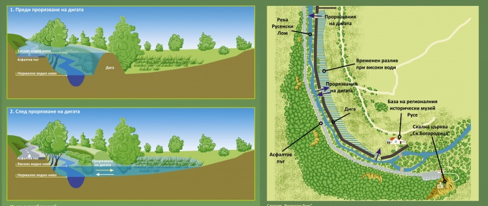Restoration of Rusenski Lom River near Ivanovo
Type 1 & 2 & 3 NBS


NBS info
| Country | Bulgaria |
| River, water body | Rusenski Lom |
| Stage | ME |
| Size | Medium |
| Geotype | Large |
| Innovative Solutions | Yes |
 |
 |
Project summary
In the mid-20th century, the lower flow of the Rusenski Lom River underwent regulation with dykes, but this proved unsuccessful in some areas due to frequent flooding and high groundwater levels. Consequently, much of the reclaimed land was converted into fishponds, which were economically inefficient and often destroyed during periods of high water. As a result, many of these fishponds now lie abandoned. This situation is evident along the Rusenski Lom river near the Ivanovo rock monasteries, where an asphalt road and visitor infrastructure sit atop river protection dykes. Despite these measures, floods frequently inundate the area, damaging access roads and infrastructure. The flood of 2006 was particularly devastating, washing away bridges and alcoves on the island, and causing partial breaches in the dykes, leaving flooded land submerged for over a year.
Best practices and references
WWF started restoring the river and measures were completed in 2009. In this case, the water itself suggested the solution to the problem. The dike was further opened in three places. It is the first example in Bulgaria for application of the principle “more space for the river – more safety for people”, proven yet in mid-20th century.
Environmental, socio-cultural, economic impacts
Thanks to this approach, now during high water the river may spread out, settle down and go back into its bed without flooding the surrounding land. At the same time, overflows in the floodplain terrace provide feeding places for the black stork, habitats for rare water plants and breeding places for a number of fish and amphibian species.
Replication and scalability
This project was implemented on a relatively small scale. Although there are some local specificities, the project is not uncommon and the techniques and approaches used are well established. In other words, there is great scope for replicating the good results and applying them elsewhere, including on a wider scale.
Participation process
The project was implemented in 2009 by the Rusenski Lom Nature Park Directorate, “Friends of Rusenski Lom” Club and WWF with the support of the Bulgarian Ministry of Culture, and was funded by WWF and the German Federal Ecological Foundation DBU. Apart from the institutions and organisations mentioned, there were no other stakeholders actively involved. The project has gone through coordination procedures with the state administration and local authorities, but there has been no public consultation process.
Lessons learnt
This is a project that has been implemented on a small area and yet has a clear socio-economic and environmental positive service. Often small projects are questioned as to whether their implementation will have a measurable effect. This is an example of a project that was not subject to public consultation and yet the lack of such consultation did not adversely affect the project.
